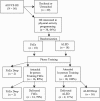Improving physical activity program adoption using integrated research-practice partnerships: an effectiveness-implementation trial
- PMID: 28299746
- PMCID: PMC5352632
- DOI: 10.1007/s13142-015-0380-6
Improving physical activity program adoption using integrated research-practice partnerships: an effectiveness-implementation trial
Abstract
Integrated research-practice partnerships (IRPPs) may improve adoption of evidence-based programs. The aim of this study is to compare adoption of an IRPP-developed physical activity (PA) program (Fit Extension, FitEx) to a typical efficacy-effectiveness-dissemination pipeline model program (Active Living Every Day, ALED). Guided by the Reach Effectiveness Adoption Implementation Maintenance (RE-AIM) framework, a randomized controlled trial assigned health educators (HEs) to FitEx (n = 18) or ALED (n = 18). Fourteen HEs adopted FitEx, while two HEs adopted ALED (χ 2 = 21.8; p < 0.05). FitEx HEs took less time to deliver (p < 0.05), stated greater intentions for continued program delivery (p < 0.05), and reached more participants (n = 1097 total; 83 % female; 70 % Caucasian; M age = 44 ± 11.8) per HE than ALED (n = 27 total; 60 % female; 50 % Caucasian; M age = 41 ± 11.3). No significant difference existed in FitEx or ALED participants' increased PA (M increase = 9.12 ±29.09 min/day; p > 0.05). IRPP-developed programs may improve PA program adoption, implementation, and maintenance and may also result in programs that have higher reach-without reducing effectiveness.
Keywords: Physical activity; RE-AIM; Research-practice; Translation.
Conflict of interest statement
Conflict of interest
The authors declared that they have no competing interests.
Adherence to ethical principles
This study followed accepted principles of ethical and professional conduct. The study received expedited review by the Virginia Tech Institutional Review Board (no. 08-466).
Figures
References
-
- U.S. Department of Health and Human Services. Office of Disease Prevention and Health Promotion. Healthy People 2020. Washington, DC. http://www.healthypeople.gov/. Accessed 1 Jul 2015.
-
- Mokdad AH, Marks JS, Stroup JF, et al. Actual causes of death in the United States, 2000. JAMA. 2004 - PubMed
-
- U.S. Department of Health and Human Services. The power of prevention. Steps to a HealthierUS: a program and policy perspective. 2003: 1–9.
-
- Morbidity and Mortality Weekly Report. Prevalence of regular physical activity among adults—United States, 2001 and 2005. 2007;56(46). - PubMed
Publication types
MeSH terms
Grants and funding
LinkOut - more resources
Full Text Sources
Other Literature Sources
Medical



